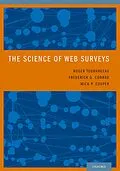The development and widespread use of Web surveys have resulted in an outpouring of research on their design. In this volume, Tourangeau, Conrad, and Couper provide a comprehensive summary and synthesis of the literature on this increasingly popular method of data collection. The book includes new integration of the authors' work with other important research on Web surveys, including a meta-analysis of studies that compare reports on sensitive topics in Web surveys with reports collected in other modes of data collection. Adopting the total survey error framework, the book examines sampling and coverage issues, nonresponse, measurement, and the issues involved in combining modes. In addition, the concluding chapter provides a model for understanding the errors in estimates that combine data collected in more than one mode. Web surveys have several important characteristics that affect their ability to collect accurate survey data. Discussing these in detail, the authors address basic design decisions from input widgets to background colors. They additionally focus on the visual character of Web surveys, on their ability to automatically interact with respondents, and on the Web as a method of self-administration. The Science of Web Surveys is relevant for those with the practical goal of improving their own surveys and those with an interest in understanding an increasingly important method of data collection.
Autorentext
Roger Tourangeau is a Vice President and Associate Director at Westat, one of the largest survey firms in the U.S. Before joining Westat, he was Research Professor at the University of Michigan's Survey Research Center and the Director of the Joint Program in Survey Methodology at the University of Maryland. He has been a survey methodologist for nearly 30 years. He is an author on more than 60 research articles, many of them on the design of web surveys. Frederick G. Conrad is a Research Professor in the Survey Research Center at the University of Michigan and the Joint Program in Survey Methodology (JPSM) at the University of Maryland. He is the Director of the Michigan Program in Survey Methodology and JPSM. He is co-author or editor of several books and numerous articles on survey methodology. His research focuses on interaction between people and between people and technology in survey data collection. Mick P. Couper is a Research Professor in the Survey Research Center at the University of Michigan and in the Joint Program in Survey Methodology (JPSM). He has been doing surveys and research on surveys for over 25 years. He is author or co-author of several books and numerous articles on survey methodology. His research focuses on the application of technology to the survey process, survey nonresponse, and alternative modes of survey data collection.
Inhalt
Preface Chapter 1: Introduction 1.1 The Total Survey Error Approach 1.2 Roadmap of the Book 1.3 The Purpose and Scope of the Book Chapter 2: Sampling and Coverage Issues for Web Surveys 2.1 Types of Web Surveys and the Use of Probability Sampling 2.2 Coverage Issues for Web Surveys 2.3 Statistical Corrections for Coverage and Sampling Bias 2.4 Summary Chapter 3: Nonresponse in Web Surveys 3.1 Defining Nonresponse and Nonresponse Error in Web Surveys 3.2 Nonresponse Error in Web Surveys 3.3 Response and Participation Rates in Web Surveys 3.4 Factors Affecting Participation in Web Surveys 3.5 Nonresponse in Mixed-Mode Surveys 3.6 Factors Affecting Breakoffs in Web Surveys 3.7 Item Nonresponse in Web Surveys 3.8 Summary Chapter 4: Introduction to Measurement and Design in Web Surveys 4.1 Measurement Error in Web Surveys 4.2 Measurement Features of Web Surveys 4.3 Choice of Broad Design Approaches 4.4 The Look and Feel of the Web Survey 4.5 Navigation Conventions 4.6 Choice of Response Formats 4.7 Grid of Matrix Questions 4.8 Summary Chapter 5: The Web as a Visual Medium 5.1 Interpreting Visual Features of Web Questionnaires 5.2 The Impact of Images 5.3 The Concept of Visibility 5.4 Summary Chapter 6: Interactive Features and Measurement Error 6.1 Dimensions of Interactivity 6.2 Responsive, Machine-Like Features 6.2.1 Progress Indicators 6.2.2 Running Tallies 6.2.3 Visual Analog Scales 6.2.4 Interactive Grids 6.2.5 Online Definitions 6.3 Human-Like Interactive Features 6.4 Summary Chapter 7: Measurement Error on the Web and in Other Modes of Data Collection 7.1 Conceptual Schemes for Understanding Mode Effects 7.2 Web Surveys as a Method of Self-Administration 7.3 Web Surveys and Cognitive Burden 7.4 Summary Chapter 8: Summary and Conclusions 8.1 Non-Observation Errors in Web Surveys 8.2 Observation Errors 8.3 A Model for Mode Effects 8.4 Recommendations for Web Surveys 8.5 The Future of Web Surveys References Author Index Subject Index
